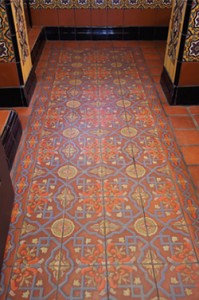How Tile Compares to Other Flooring Options
Learn why ceramic tile makes a better choice than wood, carpet, or vinyl.
 At Mission Tile West, it’s no secret that we believe stone, terra cotta, and ceramic tile make some of the best and most beautiful flooring options for every room in your home—and for outdoor spaces too. It’s not just professional bias that makes us feel this way. There are very sound reasons for choosing tile flooring over other options. Read on to learn more about how tile compares to wood, carpet, and vinyl flooring.
At Mission Tile West, it’s no secret that we believe stone, terra cotta, and ceramic tile make some of the best and most beautiful flooring options for every room in your home—and for outdoor spaces too. It’s not just professional bias that makes us feel this way. There are very sound reasons for choosing tile flooring over other options. Read on to learn more about how tile compares to wood, carpet, and vinyl flooring.
Wood
Wood flooring has an undeniable earthy appeal, but it can be delicate, and, unless you like that “distressed” look, it can be high-maintenance too. Tile, on the other hand, is resistant to scratches from pet’s claws and shifting furniture, though it is vulnerable to abrasion in high-traffic areas if sand and grit isn’t swept up promptly. Another drawback of wood is that it can warp and squeak. Ceramic tile will lay nice and flat so long as the subfloor remains in good condition. Some types of ceramic tile can even mimic the look of wood with realistic wood grain patterns.
Carpet
Of course tile can’t match the softness of carpet, but it comes in an equally large range of colors and patterns. Properly sealed tile is impervious to staining—that bane of light-colored carpets everywhere—and it has a much longer service life. Part of the reason tile last so much longer than carpet is that it is very easy to replace a single damaged tile, while a section of damaged carpet spells doom for the entire room. You can even mimic the look of a patterned area rug by using a patch of designer tiles in a larger expanse of tile flooring. This is an excellent way to help break up a large space without the hassles and trip hazards of real rugs.
Vinyl
Vinyl tile is an extremely affordable and durable floor covering, making it a popular choice for many home renovation projects. Like ceramic tile, it is easy to clean and extremely low maintenance. However, vinyl tile does come with some significant drawbacks compared to real ceramic tile. For example, vinyl flooring can be damaged by impacts from sharp objects, and any flaws in the subfloor tend to show right through the thin layer of vinyl tile. Perhaps most troubling, many types of vinyl tiles emit high levels of VOCs or harmful chemical vapors when new. Ceramic tiles do not present this health hazard provided quality low-VOC adhesives and grout are used.
